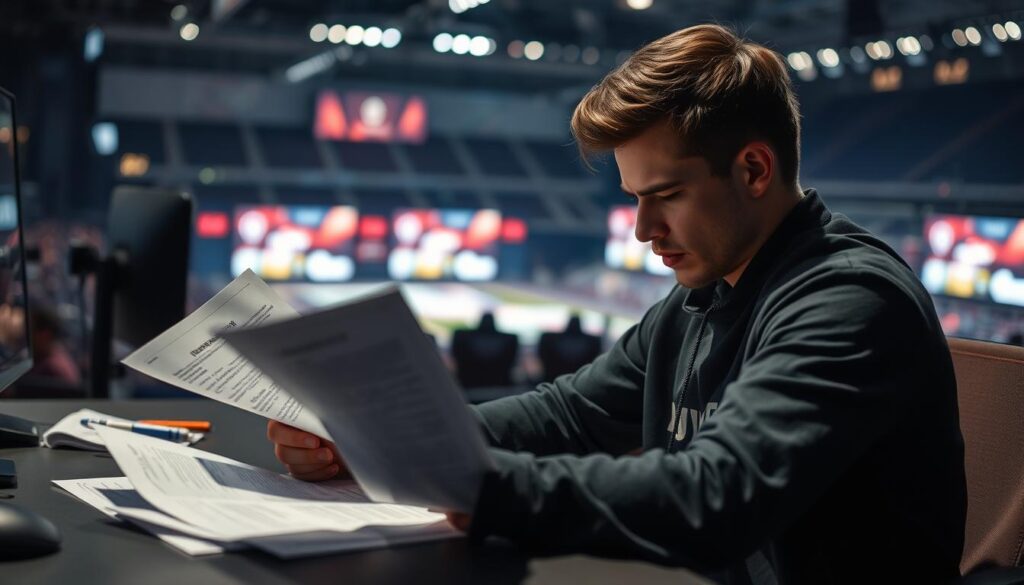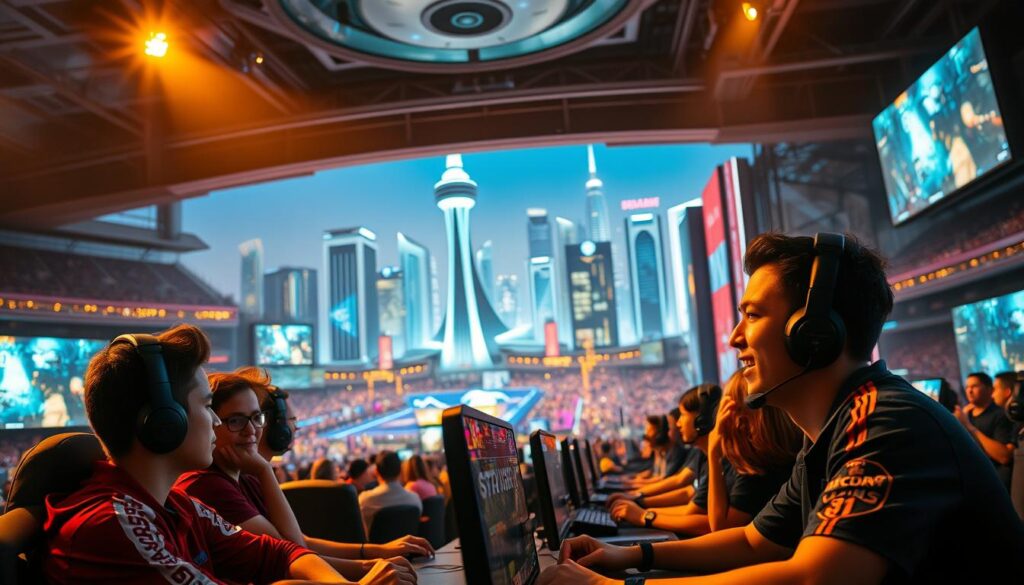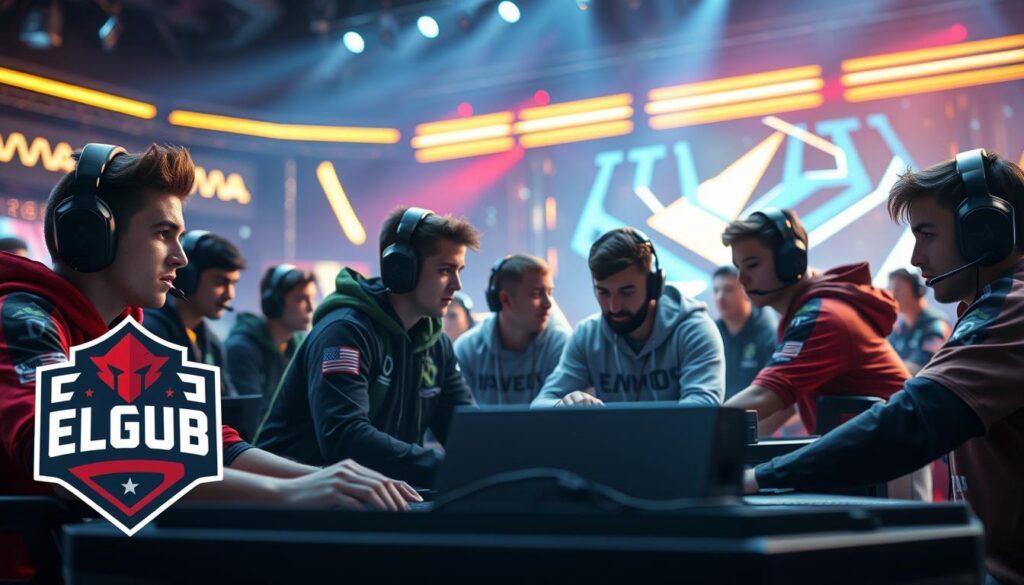Imagine a digital battlefield where quick choices can win big money. Teenagers can outplay older pros in games like Fortnite. It’s not just a game; it’s a career. Your gaming skills could get you on ESPN.
But becoming a pro gamer isn’t easy. It takes hard work and dedication. Let’s explore what it takes to go from a basement gamer to a famous pro.
Lee “Faker” Sang-hyeok is like the Michael Jordan of League of Legends. He made $20M with his fast reflexes. Kyle “Bugha” Giersdorf, just 16, won the Fortnite World Cup against 40 million players.
These gamers didn’t become stars overnight. They practiced for hours every day. They also had to negotiate contracts like chess players.
The esports world is more than just playing games. Colleges offer scholarships for gamers. Analysts study games like film critics.
Want to join? You need more than just good gaming skills. You must build your brand, stay focused, and avoid bad contracts.
So, are you ready to start your esports journey? We’ll explore the real side of gaming. It’s not all fun and games; it’s hard work and dedication.
What Does It Mean to Go Pro?
Becoming a pro gamer is more than just a job—it’s a big change. It’s like trading your skills for stocks, where every move matters. Imagine Squid Game, but instead of dolls, you’re dealing with sponsor deals and contracts.
Joining teams like Cloud9 or TSM makes your gaming skills worth a lot. It’s like investing in a new tech startup. But, it can be as unpredictable as a meme coin.
Ninja’s journey is a great example. He went from Halo 3 tournaments to a Twitch superstar. His success shows that winning isn’t just about games. It’s about building a brand and getting deals.
But, the esports world is full of surprises. For every Ninja, there’s a Sinatraa. A Valorant star whose career ended quickly due to scandals.
“Pro gaming isn’t a meritocracy—it’s a high-stakes reality show where your brand matters as much as your aim.”
So, what’s the real deal? Let’s look at it:
- Player profiles aren’t resumes—they’re PR stories. A good K/D ratio means nothing if you’re hard to work with.
- Career pathways now include making content and being an influencer (check our career pathways guide for tips).
- Planning for retirement? More like looking for a new career path, like coaching or being an analyst.
The average pro career lasts 2-5 years. That’s shorter than a Call of Duty season. You’re not just getting better at games; you’re building an empire. Are you ready to start?
Required Skills and Dedication
Forget what you’ve heard about “natural talent” – surviving the esports meat grinder needs discipline and adaptability. It’s not just about being good at games. It’s about using your free time until your friends think you’ve joined a cult.
Esports Training: Where Talent Goes to Die
T1’s Seoul facility is not just a gaming house. It’s a neuro-optimization lab with RGB lights. Their League squad works 14 hours a day, mixing target practice with sports psychology. They don’t want to be the one who tilts so hard their career becomes a Twitch emote.
As one CS:GO coach said: “Raw aim gets you signed. Systematic destruction keeps you employed.”
“We break matches like crime scenes – if you’re not reviewing VODs with the intensity of a CIA cryptanalyst, you’re just practicing mistakes.”
Top players don’t just grind matches. They reverse-engineer success through:
- VOD autopsy sessions (minimum 3 hours daily)
- Input lag calculations precise enough to trigger NASA nostalgia
- Team comms analysis that would make Freud take notes
The real secret weapon? Flowcharts. Modern teams use decision trees so complex they make IKEA manuals look like kindergarten scribbles. One Valorant strat I saw had 47 possible outcomes – Sun Tzu would’ve traded his horse for this stuff.
| Pro Training | Amateur “Practice” | |
|---|---|---|
| Daily Hours | 10-14 (structured) | 4-6 (random) |
| VOD Review | 40% of schedule | 5% if lucky |
| Mental Coaching | Mandatory | “I’m built different” |
| Win Condition Focus | Microsecond adjustments | “Headshots, bro” |
Here’s the brutal math: For every hour you spend playing, top contenders invest two hours analyzing. They track APM like stock traders watch the NASDAQ, optimizing button presses until their keyboards need PTSD counseling. Miss your daily aim trainer session? That’s not dedication – that’s unemployment.
Daily Life of a Pro Player
The esports lifestyle is like a military bootcamp. It’s fueled by Monster Energy and sleep loss. Imagine arguing about Dota 2 strategies with roommates at midnight. Then, they play scrims until the sun rises. It’s not just gaming; it’s high-pressure performance art.
Leaked schedules from Evil Geniuses’ Dota squad show the harsh reality:
| Time | Activity | Snack Probability |
|---|---|---|
| 3:00 AM | Scrim vs. Chinese teams | Red Bull (87%) |
| 7:30 AM | VOD review + flame session | Cold pizza (62%) |
| 11:00 AM | Sponsor content shoot | Regret (100%) |
| 2:00 PM | Physical therapy & cardio | Protein shake (45%) |
Veterans like Daigo Umehara share the hidden costs:
“You think you’re playing games until you realize the game’s playing you. Wrist braces become fashion accessories. Sunlight feels like a myth.”
Pro gaming is like Formula 1 racing without the champagne budget. Players deal with:
- Twitch streaming quotas
- Patch note emergencies
- Sponsor-mandated tweets
This grind creates legends. The discipline of Navy SEALs is seen in professional esports careers. Just swap night vision goggles for RGB-lit keyboards.
Burnout statistics are alarming: 68% of retired players have chronic wrist pain. 42% have sleep disorders. The esports lifestyle is about survival, not glory.
Getting Signed to a Team
Getting on a pro esports team in 2024 is more than just winning games. It’s about being a star on Twitch and having a strong online presence. FaZe Clan once signed a TikTok star, and their merchandise sales soared.

Today, esports organizations are more like casting directors. Your contract might include rules about:
- Mandatory streaming hours (with approved brand integrations)
- Social media crisis management training
- Appearance fees for IRL events (extra for cosplay)
Team Liquid has a rule about being relatable on social media. Players must be likable but also avoid controversy. It’s a delicate balance.
The New Contract Playbook
| Old School (2015) | New Meta (2024) |
|---|---|
| Win percentage | Engagement metrics |
| LAN event bonuses | Brand collab quotas |
| Mouse sponsorship | Metaverse avatar rights |
In 2024, being popular on social media is more important than winning games. Pro esports team managers look for players who can attract fans and sponsors. It’s not just about playing well.
FaZe Clan’s recent moves show the importance of choosing the right player. They picked a Valorant streamer over a CS:GO veteran. It was a calculated decision based on popularity.
If you want to make it big, you need to be more than just a good player. You must be a brand-safe influencer. Start working on your social media skills now.
Tournament Circuits and Structure
Esports tournaments are more than just exciting games. They are complex systems where strategy and math play big roles. The Dota Pro Circuit is a prime example, where teams fight for more than just victory. They aim for spots in major tournaments, just like investors chase new trends.
Fortnite’s $30M World Cup is a perfect example of this. Here’s how it works:
- Open qualifiers: 40 million players enter, mostly young people fueled by energy drinks and worries.
- Semi-finals: Almost all players are eliminated, leaving only a few to compete.
- Finals: 100 players share the prize, while Epic Games makes money from cosmetic sales.
This setup is more like The Hunger Games than a sport. Valve’s International battle pass model also raises questions. Fans spend millions on digital items to help fund the tournament. But 75% of this money goes to the developers, raising concerns about fairness.
When structuring your competition circuit, keep these points in mind:
- Regional rivalries can be exciting but often unfair.
- Open qualifiers are both opportunities and emotional challenges.
- Sponsors prioritize viewership over fair play.
Is this system flawed? Yes. But it’s also groundbreaking. Esports tournaments offer a unique blend of competition and entertainment. The real question is, what’s next in this ever-evolving world?
Contract Insights

Signing an Esports contract feels like a big commitment, like being locked into a long-term deal before you know all the details. The Riot Global Contract Database shows that 73% of rookie deals have clauses that might make Faust think twice about his deal.
Let’s look at three common pitfalls:
| Clause Type | Industry Average | Horror Story Example | Red Flag Level |
|---|---|---|---|
| Non-Compete Duration | 9-18 months | NRG’s 2022 “career timeout” clause | 🔥🔥🔥🔥 |
| Sponsorship Rights | Full org control | Ex-TSM player losing gamertag royalties | 🔥🔥🔥🔥🔥 |
| Termination Triggers | 26% win rate clauses | FaZe Clan’s infamous K/D ratio demands | 🔥🔥🔥 |
“They owned my online identity like I was a Sims character,” says former Overwatch pro Jake Lyon about his first contract. Endorsement clauses often take 50-70% of revenue, making personal brand deals very one-sided.
Here are three key negotiation tips for new players:
- Demand sunset clauses for sponsorship rights
- Cap non-compete periods at 6 months
- Require performance review escalators
Remember, Esports contracts are not like marriage proposals. They’re more like strategic games. The best players approach negotiations with a focus on career flexibility. Always have a lawyer who understands both legal terms and Twitch chat.
Tips for Aspiring Pros
Want to escape Elo hell without becoming that guy rage-posting on Reddit? Your journey needs more than just talent. It requires the strategic mind of a chess grandmaster and the emotional strength of a DMV worker on tax day. Let’s look at the essentials you need.
First rule of ranked climb: Treat your keyboard like a Stradivarius violin. Here’s how to avoid tilt:
- Grind aim trainers like you’re prepping for John Wick’s marksmanship exam
- Analyze VODs with the scrutiny of CSI investigators solving frame-perfect crimes
- Schedule breaks like NASA mission control – every 90 minutes, without exception
“Pro gaming isn’t about hitting shots – it’s about surviving the 15th consecutive loss without yeeting your monitor into orbit.”
Mental training is key to success. Try this test:
| Training Type | Time Investment | Skill Developed | Toxicity Resistance |
|---|---|---|---|
| Aim Drills | 2 hours/day | Mechanical Precision | ★☆☆☆☆ |
| VOD Analysis | 1.5 hours/day | Strategic IQ | ★★★☆☆ |
| Meditation | 20 mins/day | Mental Fortitude | ★★★★★ |
Notice how meditation – the least “gamer” activity – offers the most tilt protection? That’s why top orgs now hire sports psychologists who’d make Freud quit smoking mid-session.
When teams come knocking (and they will, if your Twitch clips go viral), remember: Contracts aren’t prenups. Negotiate like you’re trading CS:GO skins with a Russian oligarch’s kid – which, metaphorically speaking, you kinda are.
Future of Professional Esports
The esports world is like a game of Civilization. Saudi Arabia’s NEOM investments are building digital cities. At the same time, colleges are creating stats-obsessed coaches.
Player unions are making collective bargaining agreements. Teams are selling NFT jersey patches. Valorant’s franchise model offers stability, but veterans remember the Overwatch League’s demise.
Content wars are heating up. MrBeast’s YouTube army is competing with Dreamhack’s LAN legacy. Pro gamers are becoming mercenaries across platforms.
Twitch is challenging TikTok for viewers’ attention. Gen Z wants highlight reels between studying. The ultimate goal is for athletes to be true free agents.
Imagine Faker signing 1-day contracts while streaming Valorant strategies to 10 million subscribers.
Survival in esports requires a Tilt-Proof mentality. Tomorrow’s stars analyze replay analytics and negotiate Twitch clauses. Franchise fees are $50 million, but indie tournaments are growing on Discord.
One thing is certain: the meta always changes. You must adapt your strategy or risk becoming outdated. The next round begins before the bomb defusal countdown ends.




